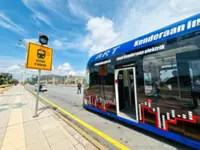Johor Baru residents say the new transit system needs to be accessible for people to consider making the switch to public transport. — Filepic
AFTER years of enduring traffic jams, Johor Baru residents are hoping the proposed elevated autonomous rapid transit (E-ART) system will offer a smoother, more efficient commute.
Administrative assistant Wong Hui Chi, 34, who commutes daily from her home in Taman Johor Jaya to Danga Bay, Johor Baru, said traffic congestion in the city has worsened in recent years.
“I usually leave the house before 8am to reach my office, located about 20km away, on time.
“Even then, it takes me about 40 minutes on a good day.
“Going home is another issue as I often get stuck in a one-hour jam; it can take up to two hours during rainy days or festive seasons,” she told StarMetro.
Wong hopes the E-ART could help ease traffic and reduce dependence on private vehicles, but emphasises the need for sufficient stops along the route.
“If the number of stations is limited, ridership will be low.
“The network needs to be accessible for people to consider making the switch to public transport,” she said.
Customer relations officer Mohd Hanif Sulaiman, 31, said the success of the E-ART system depended on integration with other public transport modes.
“There should be feeder buses and park-and-ride facilities so that more people can access the E-ART.
“In the Klang Valley, feeder buses connect neighbourhoods to LRT and MRT stations at consistent intervals, which makes planning trips much easier,” he said.
Iskandar Puteri university student M. Thanussri, 22, hopes the project will materialise soon as public transport was not just about convenience.
“It is also about sustainability and reducing carbon emissions, because if more people take the E-ART, there will be fewer cars on the road,” she said.
Thanussri said she experienced congestion daily, especially along Jalan Tebrau and Skudai Highway.
“During the recent two-week rainy spell and floods, some roads leading to my campus were closed and we had to shift to online classes.
“My daily commute typically takes 40 to 50 minutes one way, but it can stretch to over an hour during peak hours or bad weather,” she said.
Thanussri hoped the E-ART would also cover Pasir Gudang, as there were many residential and industrial areas there in need of better connectivity.
The ART is a public transportation system that blends the features of buses and trams, often running on sensor-based guidance systems instead of tracks.
Countries such China have cities with extensive ART systems.
The E-ART system was proposed by Johor government last year to help disperse traffic in the city centre as the ongoing Rapid Transit System Link project is expected to increase commuter numbers once it is completed in late 2026.
The proposed E-ART project is expected to serve three main corridors — Skudai, Tebrau and Iskandar Puteri.
In February, Transport Minister Anthony Loke said the E-ART was the preferred option over LRT, as the latter would take longer to construct.
Johor investment, trade and consumer affairs committee chairman Lee Ting Han said the request for proposal (RFP) for the project had been called by Land Public Transport Agency via its website.
The RFP document states that companies registered in Malaysia, including joint-ventures and consortiums with relevant expertise and experience, were invited to participate.
“Several private firms have expressed interest in the project and companies have been given until June 30 to submit their proposals,” said Lee.





